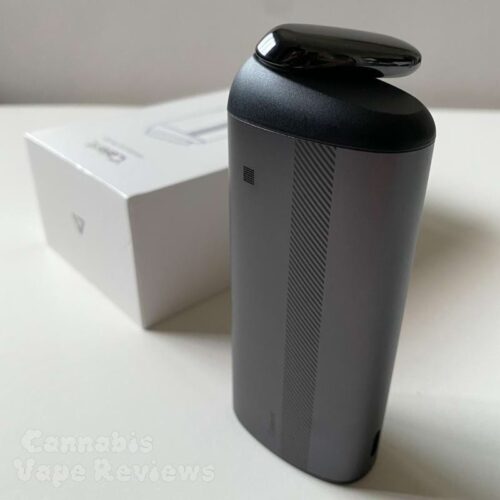Cannabis vapes let you enjoy your favorite plant without having to smoke it—but not all cannabis vape devices are the same. Most modern portable cannabis vapes use either conduction, induction or convection technology to heat your cannabis and turn the material it contains into vapor you can inhale.
The differences between these kinds of devices can majorly impact your experience—but what exactly are they? And what type of vape will be best for you? Don’t worry; we’re here to help you decide by providing a detailed breakdown of these types and what they do best.

Conduction Vapes: Pros & Cons
Conduction is the oldest and most straightforward technology used in cannabis vapes. The idea is really simple: the battery in your device heats a metal element that’s in direct contact with your herb, vaporizing the oils it contains so you can breathe them in.
Think about conduction vape technology like cooking a steak on a grill. As the metal heats up, it transfers thermal energy to the meat.
The Utillian 421 (related: Utillian 421 review) is an example of an affordable conduction vaporizer.
Summary of Conduction Heating Pros/Cons
What’s Great about Conduction Vapes?
Conduction vapes tend to be smaller, cheaper, and easier to use than convection or induction models. They lose less energy than convection models too, because heat’s going directly from the element into your herb—so they heat up your herb quicker, and their batteries sometimes tend to last longer (although this depends greatly on the quality of your device).
- Portable
- Affordable
- Easier to use
What’s the Downside?
The biggest potential problem with conduction vapes is that they can burn your herb. Go back to that idea of putting a steak on a grill—the meat needs constant attention to prevent it from being charred or cooked unevenly. Conduction vapes are the same. As a result, users can experience a burning taste that obscures the flavor of their herb.
- Less flavorful
- Can burn your herb

Conduction vapes
PAX 3 Combo Vape
DabTech Duvo X Editor choice
Furna Vape
Convection Vapes: Pros & Cons
Cannabis vapes with convection ovens use an element to heat air, which then passes into a chamber holding your cannabis. This heated air causes the material in the cannabis to evaporate so you can inhale them.
Think of a convection vape like the inside of a kitchen oven—the food inside doesn’t get cooked by direct contact with the metal; it gets cooked by the air around it, which provides more even heating.
The Utillian 620 (related: Utilian 620 review) is an example of an affordable convection vaporizer.
Summary of Convection Heating Pros/Cons
What’s Great about Convection Vapes?
Since they use air to heat your cannabis instead of direct contact with an element, convection vapes are much less likely to burn your cannabis than older conduction vapes.
- More stable (than conduction vapes)
- Excellent airflow
- Even heating
What’s the Downside?
Convection vapes aren’t as energy-efficient as other models, since transferring heat from an element to the air results in a lot of heat being lost. As a result, their batteries tend not to last as long as conduction or induction vapes. They also tend to be bigger and bulkier.
- Less energy efficient
- Larger
- Less portable
Convection vapes
G Pen Elite II
AirVape Legacy PRO Best seller
DaVinci IQ2 Carbon Fiber Best seller
Induction Vapes: Pros & Cons
For many years, cannabis vaporizers either used conduction or convection technology. But induction vapes have become considerably more popular in recent years, and are now starting to become the go-to technology for new and advanced vaporizers like the Dr. Dabber SWITCH vape.
Induction e-rig vapes
Dr. Dabber Switch 2 Best seller
Dr. Dabber SWITCH e-rig Best seller
Cannabis vape devices that have induction ovens generate a magnetic field by sending an alternating current through a metal heating coil.
Vaporizers like the Dynavap, paired with an induction heater, are seen by many as the “gold standard” of induction-based vaping.
Summary of Induction Heating Pros/Cons
What’s Great about Induction Vapes?
Cannabis vapes with induction ovens are less likely to run the risk of burning your cannabis, since the cannabis material is never in direct contact with the source of heat. Although less likely, it’s not impossible, as overheating your material can still result in combustion. Many people find that they enjoy the flavor of their material more from induction vapes because of the reduced probability of overheating or “roasting” it.
Induction heating also results in less energy being lost via heat than other methods, which means the batteries in these vapes will often last longer on a single charge than other models. Induction vaporizers tend to be very efficient compared to other heating methods.
- Better flavor
- Smoother hits
- Energy efficient
What’s the Downside?
The most notable downside of induction vapes is that they are often less portable than conduction or convection devices. Because induction vapes need to produce a magnetic field, they tend to use larger high-discharge batteries – this influences their size and shape. As well, you often need a companion device as there are few “all in one” induction vapes currently available.
For example, while the Dynavap is capable of being heated via induction, you need to actually purchase the induction vape separately.

Should You Buy a Conduction, Convection, or Induction Vape?
Conduction, convection, and induction vapes all have their advantages, which is why lots of leading brands still make more than one kind.
For instance, the Utillian 620 is an example of a convection vape, whereas its younger sibling, the Utillian 421, uses a conduction oven.
But what kind of device will be best for you? The answer depends on your budget, level of experience, and personal vaping style. Here’s how to make the decision for yourself.
If the most important thing to you is…
Saving Money
…then a conduction vape device is likely your best bet. Induction devices are relatively new vaping technology, with more sophisticated design requirements. In general, they tend to be more expensive as a result.
Convection vapes tend to be more expensive as well, since they need to be built with an extra chamber for the heated air to flow through. So you’ll often find conduction vapes more affordable than either other kind (the Utillan 421, for example, is over $80 cheaper than the 620, which is a convection vape).
Savoring Flavor
…then you’ll probably want to consider an induction vape. Don’t get us wrong—convection vapes still offer better flavor than conduction vapes, since they heat your cannabis more evenly. But induction greatly reduces the potential for burning your cannabis entirely (barring operator misuse), providing a taste that’s smoother and more pure.
Ease of Use
…then a conduction vape is probably best. They heat up your herb faster than convection vapes, which require a relatively large amount of energy to heat air to the point where it can be used to vaporize the oils in your cannabis.
Conduction vapes also have simpler designs than induction vapes. This means they’re usually lighter and more portable, allowing you to toke on the go with less fuss.
Vapor Production
…then you likely want to explore convection vape devices. The airflow needed for the heated air to properly cook your cannabis means these vapes tend to have an easier draw with more flow than other types.
Other Heating Methods for Vaporizers
While this covers the majority of the vaporizer heating systems out on the market, yet still, there is more.
Although lesser known in the cannabis space, some vapes are even starting to introduce dual-heating systems that have an advanced use of multiple types of heating.
This is typically convection combined with conduction heating. However, there’s another newcomer to the scene that uses infrared heating for vaping dry herb is the AUXO Calent. This is a reasonably priced vape that has an advanced dual-heating system that mixes both infrared and conduction.
AUXO Calent Vape
Induction heating is not as common as conduction or convection for vaporizers. Infrared is most certainly the rarest vaporizer heating method of all.
What is infrared heating? Infrared uses electromagnetic waves to provide deeper heat penetration of your cannabis which provides a more thorough vape experience.
Learn More about Conduction, Convection, & Induction Vapes
Induction vaping is newer technology, but it’s not necessarily meant to replace convection or conduction-style devices. All three kinds of devices have a place in the current market.
Convection and induction vapes will greatly decrease or eliminate the potential for you to burn your herb, but conduction vapes still make a great choice for users who want portable, affordable, and easy-to-use devices.
Past that, the choice is really yours—you might save some money on a convection device (and you’ll probably enjoy more airflow), but induction devices are typically a bit easier to use and may offer a slight edge in terms of taste.
To learn more about specific conduction, convection, or induction cannabis vapes, check out our detailed reviews—we’ve made it our business to know dry herb vaporizers inside and out, and we’re always happy to share our knowledge. With a bit of research (and a little luck), you’ll find the ideal vaporizer for your needs.
Let us know which type of heating method you prefer in the comments below.













